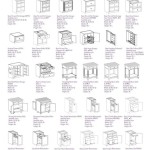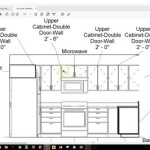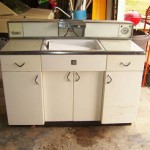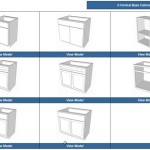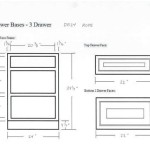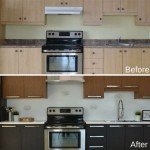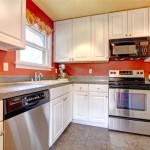How To Estimate Cost For Kitchen Cabinets
Estimating the cost of kitchen cabinets is a crucial step in any kitchen renovation project. It allows homeowners to establish a budget, compare quotes from different suppliers, and make informed decisions about design and materials. An accurate estimation requires a thorough understanding of the various factors that influence cabinet pricing, including cabinet type, materials, size, construction quality, and installation complexities.
Several methods can be used to estimate the cost of kitchen cabinets, ranging from simple rules of thumb to more detailed calculations. It's important to consider the scope of the project and the level of accuracy required when choosing an estimation method. Using a combination of methods can often provide a more comprehensive and realistic cost projection.
Understanding the Different Types of Kitchen Cabinets
The type of kitchen cabinets selected significantly impacts the overall cost. Cabinets are generally categorized into three main types: stock, semi-custom, and custom.
Stock Cabinets: These are pre-manufactured cabinets available in standard sizes and styles. Stock cabinets are typically the most affordable option due to mass production. They are readily available at most home improvement stores and can be a practical choice for budget-conscious renovations. However, the limited range of sizes and styles may restrict design flexibility and potentially require modifications to the kitchen layout to accommodate the standard dimensions.
Semi-Custom Cabinets: These cabinets offer a wider range of sizes, styles, and finishes than stock cabinets. While still based on standard sizes, semi-custom cabinets allow for some modifications, such as adjusting the depth or width to better fit the kitchen space. This additional flexibility comes at a higher price point than stock cabinets, but it can be a valuable compromise for homeowners who desire a more personalized look without the expense of fully custom cabinetry.
Custom Cabinets: Custom cabinets are built to order, allowing for complete design control and precise measurements. They are the most expensive option but provide the ultimate in personalization and fit. Homeowners can specify the exact dimensions, materials, finishes, and features, ensuring a perfect fit for their kitchen and reflecting their unique style. Custom cabinets are often the preferred choice for kitchens with unusual layouts or specific design requirements.
When estimating the cost, it's crucial to determine which type of cabinet best suits the budget and design preferences. Contacting local cabinet makers or visiting showrooms to explore the available options and associated price ranges is highly recommended.
Key Cost Factors Influencing Cabinet Prices
Several factors contribute to the overall cost of kitchen cabinets, including the materials used, construction methods, hardware, and any special features or finishes. A comprehensive estimation should consider each of these elements.
Materials: The type of wood or material used for the cabinet boxes and doors significantly affects the price. Solid wood cabinets, such as oak, maple, or cherry, are typically the most expensive due to their durability and aesthetic appeal. Plywood is another common material for cabinet boxes, known for its strength and resistance to warping. Medium-density fiberboard (MDF) is a less expensive option, often used for cabinet doors and painted surfaces. Laminate and thermofoil are also popular choices for cabinet doors, offering a durable and easy-to-clean surface at a lower cost.
Construction Quality: The construction method directly impacts the durability and longevity of the cabinets. Features like dovetail joints, solid wood drawer boxes, and soft-close hinges contribute to higher quality and, consequently, higher prices. Cabinets with a face frame construction are generally more rigid and durable than frameless (European-style) cabinets, although both options offer distinct aesthetic advantages. The type of finish applied also affects the price, with multi-step finishes and custom glazes adding to the cost.
Hardware and Accessories: Handles, knobs, hinges, and drawer slides are essential components that can significantly impact the overall cost. Decorative hardware, such as custom-designed pulls or intricate hinges, can add a touch of elegance but also increase the budget. Features like pull-out shelves, spice racks, and built-in organizers enhance functionality but represent an additional expense. Consider the quality and functionality of the hardware and accessories when estimating the cost of kitchen cabinets.
Finishes: The type and complexity of the cabinet finish will add to the overall cost. Painted cabinets generally require more labor and materials than stained cabinets, increasing their price. Specialty finishes, such as glazing, distressing, or antiquing, also contribute to a higher price point due to the added labor and expertise involved. Consider the desired aesthetic and durability requirements when selecting a finish.
Cabinet Size and Configuration: The number and size of the cabinets needed will directly influence the total cost. Larger kitchens naturally require more cabinets, leading to a higher overall expense. Complex cabinet configurations, such as corner cabinets or appliance garages, also tend to be more expensive than standard cabinets. When planning the kitchen layout, consider optimizing cabinet sizes and configurations to minimize waste and control costs.
Methods for Estimating Kitchen Cabinet Costs
Various methods can be employed to estimate the cost of kitchen cabinets. These methods range from basic rules of thumb to more sophisticated calculations that consider the specific details of the project.
Linear Foot Method This involves estimating the cost per linear foot of cabinet space. This method is often used for quick, preliminary estimations. A kitchen designer or cabinet supplier can provide a price range per linear foot based on the type of cabinet, materials, and finishes selected. Multiply the total linear feet of cabinets needed by the estimated price per linear foot to arrive at a rough estimate. For example, if the kitchen requires 20 linear feet of cabinets and the estimated cost per linear foot is $500, the estimated cost for the cabinets would be $10,000. This method does not take into account the complexity of the design or the specific features of the cabinets, so it is best used as a starting point.
Percentage of Project Cost Method: This method allocates a percentage of the total kitchen renovation budget to cabinets. A common guideline suggests that cabinets typically account for 30% to 40% of the overall renovation cost. To use this method, estimate the total cost of the entire kitchen renovation project, including labor, materials, appliances, and other related expenses. Multiply the total project cost by the appropriate percentage range (30% to 40%) to determine the estimated cabinet cost. For instance, if the total kitchen renovation is estimated at $30,000, using a 35% allocation, the estimated cabinet cost would be $10,500. This method provides a broad estimate but does not consider the specific characteristics of the cabinets.
Per-Cabinet Pricing: Obtaining a detailed quote from a cabinet supplier or contractor is the most accurate method for estimating cabinet costs. This involves providing detailed specifications, including the number of cabinets, sizes, materials, finishes, and any special features. The supplier will then provide a per-cabinet price based on these specifications. Multiply the number of each type of cabinet by its corresponding price to arrive at the total cabinet cost. For example, if the kitchen requires 10 base cabinets at $600 each and 5 upper cabinets at $400 each, the total cabinet cost would be (10 x $600) + (5 x $400) = $8,000. This method provides a more accurate estimate than the previous two, as it considers the specific details of the cabinet order.
Software And Online Tools: Numerous online tools and software programs are available to assist in estimating kitchen cabinet costs. These tools typically require users to input information about the kitchen layout, cabinet types, materials, and finishes. The software then generates an estimated cost based on the provided data. While these tools can be helpful, it's important to remember that they are only as accurate as the information inputted. Additionally, pricing data may not be entirely up-to-date or reflect local market conditions. It is recommended to supplement the results from these tools with quotes from local suppliers or contractors.
Professional Consultation: Engaging a kitchen designer or contractor is the best way to obtain an accurate and detailed cost estimate. These professionals have extensive experience in kitchen renovations and can provide expert guidance on cabinet selection, design, and installation. They can also provide realistic pricing based on their knowledge of local market conditions and supplier relationships. While there may be a cost associated with a professional consultation, it can be a worthwhile investment to ensure that the cabinet cost estimate is accurate and that the project stays within budget.
When estimating kitchen cabinet costs, it's crucial to obtain multiple quotes from different suppliers or contractors. This allows for comparison shopping and ensures that the homeowner is receiving a fair price. Be sure to provide the same specifications to each supplier to ensure that the quotes are comparable. Review the quotes carefully and ask for clarification on any items that are unclear. Consider the reputation and experience of the supplier or contractor when making a decision.
In addition to the cost of the cabinets themselves, it's important to factor in the cost of installation. Cabinet installation can be a complex and time-consuming process, and it's typically best left to professionals. Installation costs can vary depending on the complexity of the job, the type of cabinets, and the location. Be sure to obtain a detailed installation quote from a qualified installer before proceeding with the project. Also, demolition of existing cabinets, if required, will add to the total budget.
Estimating the cost of kitchen cabinets is an important step in any kitchen renovation project. By understanding the different types of cabinets, the key cost factors, and the various estimation methods, homeowners can make informed decisions and stay within their budget. Using a combination of estimation methods, obtaining multiple quotes, and engaging a professional consultant can help ensure an accurate and realistic cost projection.

How To Estimate The Cost Of A Stunning Kitchen Renovation Interior Designs By Adrienne Full Service Design Cranbrook B C

How Much Do Custom Cabinets Cost

Kitchen Cabinet Cost Estimator Avoid Errors Save Time

What Is The Average Kitchen Cabinet Cost

Sample Kitchen Cost Estimate Sheet Calculator Cabinets Templat Remodel Checklist Remodeling Costs

What Is The Average Kitchen Cabinet Cost

How Much Does A Kitchen Remodel Cost 2024 Average

How Much Do New Cabinets Cost Bkc Kitchen And Bath

Average Cost To Replace Cabinets Forbes Home

What Do Kitchen Cabinets Cost Tips To Stay In Budget
Related Posts


